Summary
Neisseria gonorrhoeae is responsible for causing one of the most frequent sexually transmitted diseases known as gonorrhea. Unlike N.meningitidis, the presence of N. gonorrhoeae in a specimen is always of clinical importance [1]. Its exclusive natural host is humans, and it has fastidious growth requirements [2].
Neisseria gonorrhoeae is responsible for causing one of the most frequent sexually transmitted diseases known as gonorrhea. Unlike N.meningitidis, the presence of N. gonorrhoeae in a specimen is always of clinical importance [1]. Its exclusive natural host is humans, and it has fastidious growth requirements [2].
Staining and Microbiologic Features:
- Gram-negative diplococci [3]
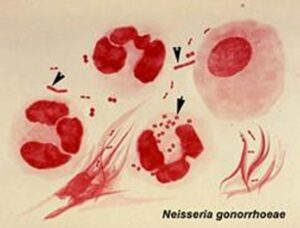
ff neisseria gonorrhoeae” by isis325 is licensed under CC BY 2.0.
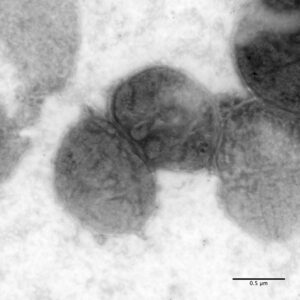
Neisseria gonorrhoeae cells” by Oregon State University is licensed under CC BY-SA 2.0
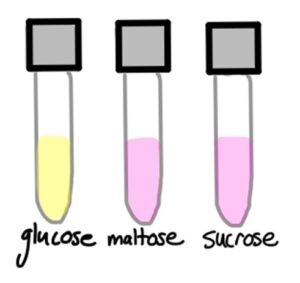
File:Carbohydrate fermentation gonorrhea.png” by NewDancinShoes is licensed under CC BY-SA 4.0.
- N. gonorrhoeae shows optimum growth at 35°C to 37°C and thrives on enriched chocolate agar and other supplemented media, as its growth requires cysteine and an energy source. [1]
Virulence:
- Pili of N. gonorrhoeae not only help in motility but are also used for attachment to epithelial cells [5]
- Genetic recombination of pili genes provide protection against antibodies [6]
- N. gonorrhoeae may elude phagocytosis by closely adhering to host cells using these pili [6]
- Porin proteins (such as PorB) help the organism to invade the epithelial cells. Furthermore, these proteins also disrupt the neutrophil degranulation. [7]
- N. gonorrhoeae also expresses Opa proteins that help in bacterial adhesion and invasion. [6]
- N. gonorrhoeae can lyse IgA antibodies by producing IgA1 protease [2]
- It has also developed an acquisition system to extract iron from the host to meet its metabolic requirements. [2]
- The ability to produce β-Lactamase can promote resistance against penicillin [8]
- Lipooligosaccharide in the cell wall of N. gonorrhoeae lacks O-antigen polysaccharide. [8]
- Does not produce exotoxins [2]
- Plasmids containing the tetM gene provide resistance to tetracyclines, while those encoding TEM-1 β-lactamases confer penicillin resistance. [9, 11]
Transmission:
- Unprotected sexual contact
- Neonatal transmission is also possible during delivery
Diseases and Complications:
- In Men: Asymptomatic or can present with frequent urination, dysuria, and purulent urethral discharge. May result in prostatitis and epididymitis. Rectal infection can occur in men who engage in same-sex relations, and they can present with rectal pain, bleeding, and discharge. [6,9]
- In Women: Mostly asymptomatic. Some may present with urethritis, cervicitis, or pelvic inflammatory disease. Patients with an intrauterine device are at an elevated risk of progression of cervical infection into PID. ,[9] Subsequent scarring of fallopian tubes in patients with PID can interfere with the passage of sperm or eggs, resulting in sterility or ectopic pregnancy. Infection may involve the perihepatic capsule and result in Fitz-Hugh-Curtis syndrome. [9]
- In Newborns: Transmission to neonates during delivery can result in Ophthalmia neonatorum. Erythromycin eye drops are appropriate for protection against both N. gonorrhea and chlamydia. [9]
- It can enter the bloodstream and cause disseminated infection. The affected patient may present with fever, arthralgias, and pustular rash. [10]
- It can also result in septic arthritis. [9]
Diagnostic Testing:
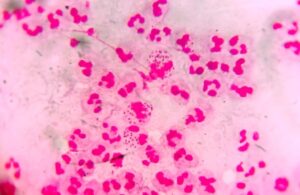
File:Neisseria gonorrhoeae in urethral discharge.jpg” by Microrao is licensed under CC BY-SA 4.0.
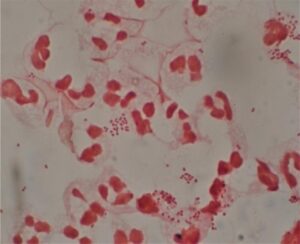
Neisseria gonorrhoeae and pus cells” by Dr Graham Beards is licensed under CC BY-SA 4.0.
- Culture from genital specimen [12]
- Blood cultures for gonococcal dissemination [12]
- Nucleic acid amplification (NAA) assays or antigen testing [13]
References:
1 First Aid for USMLE step 1, 2021 edition (page no: 141)
2 CMMRS edition 6, 2016-17 (page no: 70)
3 First Aid for USMLE step 1, 2021 edition (page no: 142)
4 Medical Microbiology by Patrick R. Murray Ph.D., Ken Rosenthal Ph.D., Michael A. Pfaller MD, 8th edition (page no: 235)
5 Medical Microbiology, 8th edition (page no: 236)
6 CMMRS edition 6, 2016-17 (page no: 66)
7 Medical Microbiology by Patrick R. Murray Ph.D., Ken Rosenthal Ph.D., Michael A. Pfaller MD, 8th edition (page no: 236, 237)
8 Medical Microbiology by Patrick R. Murray Ph.D., Ken Rosenthal Ph.D., Michael A. Pfaller MD, 8th edition (page no: 237)
9 CMMRS edition 6, 2016-17 (page no: 67)
10Medical Microbiology by Patrick R. Murray Ph.D., Ken Rosenthal Ph.D., Michael A. Pfaller MD, 8th edition (page no: 239)
11 Jawetz, Melnick, & Adelberg’s Medical Microbiology Twenty-Seventh Edition (page no: 284, 85)
12 Step-Up to Medicine, 6th edition (page no: 386)
13 Medical Microbiology by Patrick R. Murray Ph.D., Ken Rosenthal Ph.D., Michael A. Pfaller MD, 8th edition (page no: 240)

